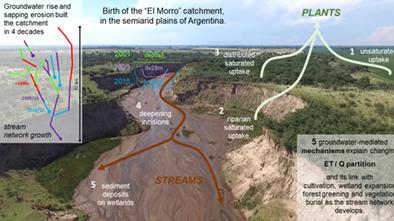当前位置:
X-MOL 学术
›
Hydrol. Process.
›
论文详情
Our official English website, www.x-mol.net, welcomes your
feedback! (Note: you will need to create a separate account there.)
Plants versus streams: Their groundwater‐mediated competition at “El Morro,” a developing catchment in the dry plains of Argentina
Hydrological Processes ( IF 2.8 ) Pub Date : 2021-04-25 , DOI: 10.1002/hyp.14188 Esteban G. Jobbágy 1 , Santiago Lorenzo 2 , Nicolás Buono 3 , Ricardo Páez 1 , Yésica Diaz 1 , Victoria Marchesini 1 , Marcelo D. Nosetto 1, 4
Hydrological Processes ( IF 2.8 ) Pub Date : 2021-04-25 , DOI: 10.1002/hyp.14188 Esteban G. Jobbágy 1 , Santiago Lorenzo 2 , Nicolás Buono 3 , Ricardo Páez 1 , Yésica Diaz 1 , Victoria Marchesini 1 , Marcelo D. Nosetto 1, 4
Affiliation

|
Our understanding of how groundwater mediates evapotranspiration/streamflow partitioning is still fragmented and catchment studies under changing vegetation conditions can provide a useful frame for integration. We explored this partition in a flat sedimentary dry catchment in central Argentina in which the replacement of native vegetation with rainfed crops was accompanied by the abrupt formation of groundwater‐fed streams by subsurface erosion (i.e., sapping) episodes. Historical records indicated widespread water table rises (~0.3 m y−1 on average). Groundwater level and stream baseflow fluctuated seasonally with minima in the warm rainy season, indicating that evaporative discharge rather than rainfall shapes saturated flows. Diurnal groundwater level fluctuations showed that plant uptake was widespread where water tables are shallow (<3 m) but restricted to deep‐rooted Prosopis forests where they are deep (7–10 m). MODIS and LANDSAT NDVI revealed a long‐term greening for native vegetation, new wetlands included, but not for croplands, suggesting more limited evapotranspiration‐groundwater level regulation under agriculture. Close to the deepest (20 m) and most active incisions, groundwater level and greenness declined and stream baseflow showed no seasonal fluctuations, hinting decoupling from evapotranspiration. Intense ecological and geomorphological transformations in this catchment exposed the interplay of five mechanisms governing evapotranspiration/streamflow partition including (a) unsaturated uptake and both (b) riparian and (c) distributed uptake from the saturated zone by plants, as well as (d) deepening incisions and (e) sediment deposits over riparian zones by streams. Acknowledging the complex interplay of these mechanisms with groundwater is crucial to predict and manage future hydrological changes in the dry plains of South America.
中文翻译:

植物与溪流:在阿根廷干旱平原集水区“ El Morro”的地下水竞争
我们对地下水如何介导蒸散/水流分配的理解仍然是零散的,在不断变化的植被条件下的流域研究可以为整合提供有用的框架。我们在阿根廷中部一个平坦的沉积干旱集水区中探索了该分区,在该地区中,用雨养作物替代了原生植被,并伴随着地下侵蚀(即流干)事件而突然形成了由地下水喂养的水流。历史记录表明,地下水位普遍上升(〜0.3 my -1一般)。在温暖的雨季中,地下水位和河流基流季节性变化最小,表明蒸发排放而不是降雨影响了饱和流量。地下水水位的昼夜波动表明,在地下水位较浅(<3 m)的地方,植物的吸收很普遍,但仅限于根深较深(7–10 m)的深根的Prosopis森林。MODIS和LANDSAT NDVI揭示了对本地植被(包括新的湿地)的长期绿化,但对农田没有,这表明在农业条件下对蒸散量-地下水水位的调节更为有限。在最深处(20 m)和最活跃的切口附近,地下水位和绿度下降,溪流基流没有显示出季节性波动,暗示着与蒸散的脱钩。该流域强烈的生态和地貌转换揭示了控制蒸散/水流分配的五种机制的相互作用,包括(a)不饱和吸收和(b)河岸和(c)植物从饱和带的吸收分布,以及(d)加深切口和(e)河水在河岸带上的沉积物沉积。认识到这些机制与地下水的复杂相互作用对于预测和管理南美干旱平原未来的水文变化至关重要。
更新日期:2021-05-11
中文翻译:

植物与溪流:在阿根廷干旱平原集水区“ El Morro”的地下水竞争
我们对地下水如何介导蒸散/水流分配的理解仍然是零散的,在不断变化的植被条件下的流域研究可以为整合提供有用的框架。我们在阿根廷中部一个平坦的沉积干旱集水区中探索了该分区,在该地区中,用雨养作物替代了原生植被,并伴随着地下侵蚀(即流干)事件而突然形成了由地下水喂养的水流。历史记录表明,地下水位普遍上升(〜0.3 my -1一般)。在温暖的雨季中,地下水位和河流基流季节性变化最小,表明蒸发排放而不是降雨影响了饱和流量。地下水水位的昼夜波动表明,在地下水位较浅(<3 m)的地方,植物的吸收很普遍,但仅限于根深较深(7–10 m)的深根的Prosopis森林。MODIS和LANDSAT NDVI揭示了对本地植被(包括新的湿地)的长期绿化,但对农田没有,这表明在农业条件下对蒸散量-地下水水位的调节更为有限。在最深处(20 m)和最活跃的切口附近,地下水位和绿度下降,溪流基流没有显示出季节性波动,暗示着与蒸散的脱钩。该流域强烈的生态和地貌转换揭示了控制蒸散/水流分配的五种机制的相互作用,包括(a)不饱和吸收和(b)河岸和(c)植物从饱和带的吸收分布,以及(d)加深切口和(e)河水在河岸带上的沉积物沉积。认识到这些机制与地下水的复杂相互作用对于预测和管理南美干旱平原未来的水文变化至关重要。











































 京公网安备 11010802027423号
京公网安备 11010802027423号